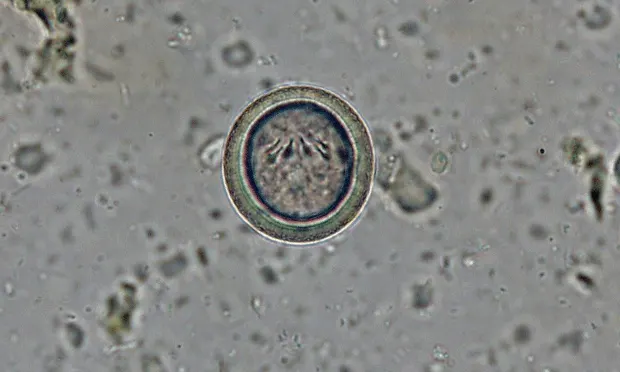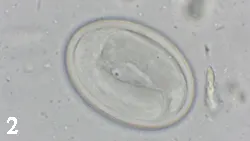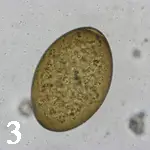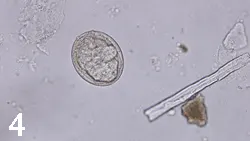Fecal Examination Techniques
Michael W. Dryden
Patricia A. Payne

Intestinal parasites are both a real and client-perceived problem in companion animals.
Most clients are well aware that puppies and kittens have worms and expect their veterinarian to use proper diagnostic techniques and treatment protocols. Because many companion animal parasites are zoonotic, veterinarians and clinical staff must be up to date on the best diagnostic techniques.
To ensure the health and well-being of pets and reduce the chance of transmission of potentially zoonotic parasites, fecal examinations for parasite eggs, oocysts, and cysts are important. Many different procedures and techniques are used, each with its own advantages and limitations.
This article reviews the most commonly used fecal examination techniques. Reliability of results depends on following protocols, using an adequate sample size, and ensuring qualifications and training of the technician or veterinarian conducting the fecal examination.
Direct Smears
Indications
For recovery of motile trophozoites of protozoan parasites, such as Giardia species and Tritrichomonas foetus.
Advantages
Rapid screening of fecal material with the ability to observe motile trophozoites that may be distorted and killed in hypertonic flotation solutions
Disadvantages
The small volume of feces renders sensitivity low1 and differentiation and identification of trophozoites can be difficult.
Reliability of Results
Dependent on experience and skill of person examining the slide and the presence and viability of the trophozoites in the small-sample volume.
Economic Impact
Minimal
Centrifugation Fecal Flotation
Indications
For diagnosis of parasitic infections when the diagnostic stage can be recovered in feces. Useful as part of routine wellness checks or when clinical signs increase the level of suspicion for parasitic infection.

Advantages
Several studies and publications document that centrifugation fecal flotation recovers significantly more eggs and oocysts and has fewer false-negative results than passive flotation systems.<sup1–6sup> While investigators did not find more positive samples with the centrifugation method, the data did show that the centrifugation method recovered 1.5 to 4 times more eggs than passive flotation.7
Salt solutions (NaCl, NaNO3, ZnSO4) have been commonly used for fecal flotation in veterinary practices, primarily because they are commercially available and zinc sulfate has been considered the best solution for recovery of Giardia species cysts.
Centrifugation fecal flotation using Sheather’s sugar solution (specific gravity, 1.27), which is now commercially available, can recover more eggs with a mean specific gravity above <sup1.2,sup> such as Taenia (Figure 1) and Physaloptera species (Figure 2), than standard salt solutions (eg, zinc sulfate and sodium nitrate; specific gravity, 1.18–1.2). Sodium nitrate solutions can be made with higher specific gravity, but slides must be examined quickly before solution crystallizes.
Disadvantages
Requires the use of a centrifuge, either swinging or fixed-head rotor. Overfilling test tubes with sugar solution can leave a sticky residue in the centrifuge. Giardia species cysts are distorted and may be destroyed by Sheather’s sugar solution.
Reliability of Results
Directly related to strict adherence to proper procedure and the skill and experience of person examining microscope slide. A well-performed technique by a qualified person will yield very reliable results. On the basis of reported data, a centrifugation technique using Sheather’s sugar solution is the best method for a routine fecal flotation in a private practice and is now considered to be the gold standard technique.
Economic Impact
Moderate—identification of more positive fecal results translates directly into more antiparasitic treatments.
Passive Fecal Flotation
Indications
For diagnosis of parasitic infections as part of routine wellness checks when the diagnostic stage can be recovered in the feces or when clinical signs increase level of suspicion for parasitic infection.
Advantages
Fairly easy to conduct, especially if a commercial device is used; often less expensive than centrifugation techniques. A passive technique can be conducted when a centrifuge capable of fecal flotation is not available.
Disadvantages
Less efficient than centrifugation techniques; recovers fewer eggs and yields more false-negative results.<sup1–5sup>
Reliability of Results
Reduced efficiency may be important if a puppy with roundworm eggs is not identified and the pet owner’s environment becomes contaminated with infective eggs, resulting in visceral or ocular larva migrans.
Economic Impact
Moderate—fewer positive fecal samples and therefore fewer antiparasitic treatments.
Baermann Technique
Indications
Used to recover larvae from intestinal or lung parasitic infections where the diagnostic stage is a larvae rather than an egg.
Advantages
Allows the recovery of larvae that would otherwise be destroyed by flotation solutions.
Disadvantages
A lengthy procedure that takes at least 4 hours; requires equipment not commonly used in a veterinary practice; and, if feces are not fresh or are contaminated with soil, requires differentiation between larvae truly in the diagnostic stage, larvae hatched from hookworm or strongyle-type eggs, and free-living larvae.
Reliability of Results
As with other fecal techniques, reliability of results is directly related to strict adherence to proper procedure and the skill and experience of person examining microscope slide.
Economic Impact
Minimal

Sedimentation Examination
Indications
Primarily used to identify eggs of internal parasites that do not float well due to high specific gravity or presence of an operculum (eggs of flukes and false tapeworms).
Advantages
Allows recovery of parasite eggs that are not readily recovered by fecal flotation, such as eggs of Trematodes (eg, Alaria species; Figure 3), Paragonimus species, and Heterobilharzia species (Figure 4).

Disadvantages
A more involved process than fecal flotation; takes several minutes to examine slides. A procedure not commonly used in private veterinary practice; therefore, personnel are likely not trained to conduct the procedure.
Reliability of Results
As with other fecal techniques, reliability of results is directly related to strict adherence to proper procedure and the skill and experience of person examining microscope slides.
Economic Impact
Minimal
Giardia Antigen Test
Indications
Used to identify dogs and cats that have clinical disease associated with Giardia species. The commercially available in-clinic veterinary test detects Giardia cyst antigen.
Advantages
Allows rapid detection of Giardia cyst antigen in animals with clinical giardiasis.
Disadvantages
False-negative results can occur. This may happen when cysts are shed intermittently, and antigen may not be uniformly distributed throughout the fecal mass.2
Reliability of Results
If cyst antigen is present in the sample, the test is highly reliable, with rare false-positive results. The SNAP test may detect Giardia species cyst antigen in adult dogs and cats without clinical signs, probably due to numerous sources of environmental contamination or chronic carriers.
Economic Impact
Minimal
The “How” of Fecal Examination Techniques
Direct Smear
A small amount of feces is transferred to a microscope slide and mixed with saline to produce a layer thin enough to read newsprint through. A coverslip is placed on the slide for viewing under the microscope.
Flotation
Flotation techniques rely on the differences between specific gravity of the egg(s), fecal debris, and flotation solution. Simply, the flotation solution must have a specific gravity higher than that of the parasite diagnostic stage you are trying to recover. Since specific gravity of most parasite eggs is 1.05 to 1.23, you must use a flotation solution with a specific gravity of at least 1.24.1 These protocols should include at least 2 g of feces. Technicians should routinely check the specific gravity of the flotation solutions and use timers to ensure sufficient wait times.
Baermann Technique
This technique is based on the active migration or movement of larvae out of feces into water. These larvae are unable to swim freely in water and therefore sink to the bottom of the apparatus, where they can be collected for identification.
Sedimentation Examination
This procedure allows for debris and eggs present in fecal samples to simply settle at the bottom of the apparatus.